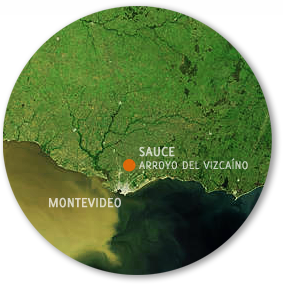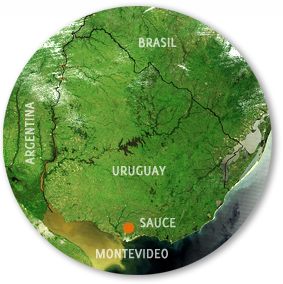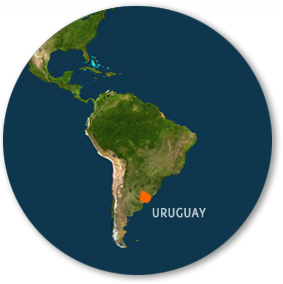The discovery made at Arroyo del Vizcaíno, in Canelones, Uruguay, depicts the long-gone giant mammals as they were and, in addition, offers unexpected evidence of human presence far earlier than had been accepted.
Vizcaíno stream
This stream is a minor course, whose headwaters are not very distant from the palaeontological site and that is an eventual tributary of the very Pando stream that so many people cross near its mouth in the weekends. Despite intense human intervention, it is still the habitat of clams, fish and birds.
The outcrop lies aout 4 km northeast from town of Sauce. Private land must be crossed to reach the place, so we do not encourage unexpected visits. Besides, if we’re not digging, the water covers the site.
To do our work, the course has to be dammed and diverted into a bypass, and the water has to be pumped out.
In the neighbouring area, the soil lies on the Cretaceous silicified sandstones of the Mercedes Formation. In the low places, Quaternary sediments, like those treated here, tend to pile up.
Sauce
Surrounded by vineyards, this small city in the departamento (administrative division equivalent to a province in federal countries) de Canelones is about 35 km from Montevideo, the nation’s capital. It has historical importance due to the Uruguayan national hero José Artigas have been born there. Ciudad natal de Artigas, en Sauce se respira la historia y el aroma de los viñedos locales.
About 13 thousand people live in the area, their usual activities being trade, small industry, production of wine and farm products. In this area several historical facts took place, like battles in the war of independence and in the civil wars of the 19th century.
Uruguay
Uruguay, officially the Oriental Republic of Uruguay or the Eastern Republic of Uruguay or the Republic East of the Uruguay (River) (Spanish: República Oriental del Uruguay). This South American country lies in between Brazil and Argentina and has extense coasts on the Río de la Plata and the southern Atlantic ocean.
Located entirely within a temperate zone, Uruguay has a subtropical climate that is relatively mild and fairly uniform nationwide. Seasonal variations are pronounced, but extremes in temperature are rare. Its estimated population is about 3.4 million.
The landscape is mostly composed of rolling plains and low hill ranges (called cuchillas in vernacular Spanish) with a fertile coastal lowland. A dense fluvial network covers the country, consisting of four river basins: the Río de la Plata, the Uruguay River, the Laguna Merín and the Río Negro. The major internal river is the Río Negro (‘Black River’). Several lagoons are found along the Atlantic coast.










